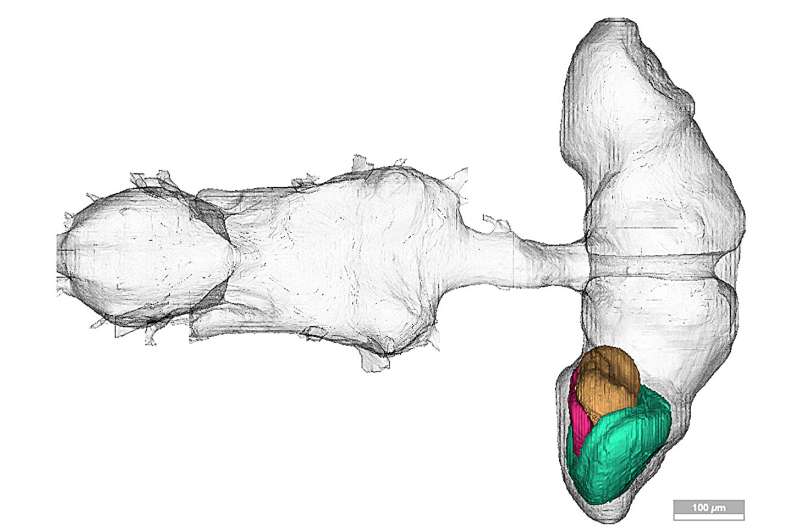This article has been reviewed according to Science X's editorial process and policies. Editors have highlighted the following attributes while ensuring the content's credibility:
fact-checked
preprint
trusted source
proofread
Seeing is believing: Scientists reveal connectome of the fruit fly visual system

Janelia scientists and collaborators have reached another milestone in connectomics, unveiling a comprehensive wiring diagram of the fruit fly visual system. The work has been released on the pre-print server bioRxiv.
The optic lobe connectome provides a map of the more than 50,000 neurons that form the fruit fly's visual system, giving scientists the fullest picture yet of one of the most intriguing and important parts of the nervous system.
Like humans and other animals, flies rely on their vision to carry out behaviors essential for survival. The optic lobes, which make up half the fly's brain and connect to its eyes, receive and process visual information. They enable the tiny insect to see a looming predator, fly to a ripe banana, or walk towards a potential mate.
For decades, researchers have chipped away at mapping small regions of the optic lobe, but these efforts yielded insight into only discrete areas, leaving scientists to speculate about how the whole system worked together.
Now, the optic lobe connectome provides a comprehensive map of the thousands of cells that make up the visual system and the millions of connections between them. The data makes it possible for scientists to answer many previously unanswerable questions, and generate dozens of new ones.
Insights gleaned from the fruit fly visual system could increase knowledge about the basic principles of how vision works, and help scientists understand more complex visual systems, like those of humans.
"If you only have the pieces, you are missing the big picture, literally, and so the idea here is to deliver a complete visual system," says Janelia Senior Group Leader Michael Reiser, who helped lead the project. "There is no single experiment we could be doing right now that would get us an answer faster than connectomic analysis."
The optic lobe connectome is part of a larger effort by the Janelia FlyEM Project Team to map the entire fruit fly nervous system that, when completed, will include the newly released optic lobe along with the rest of the fly brain and the ventral nerve cord.
While Janelia researchers and collaborators have mapped some of these parts of the nervous system separately—including the hemibrain released in 2020 and the nerve cord released last year—the forthcoming connectome will be the first map of the entire nervous system of a single fly. The optic lobe is the "big tip of this iceberg."
"This is a very special brain because probably no one on the planet—and certainly no one at Janelia—has successfully imaged an entire nervous system that includes the head brain and the ventral nerve cord in the same volume that is of sufficient quality to connect them," says Stuart Berg, FlyEM Project Team project scientist and principal software engineer.
The effort is made possible by Janelia's FlyEM Project Team, which has developed and honed a process for generating high-quality connectomes. The team uses high-resolution focused ion bean scanning electron microscopy to image the samples, high-powered computers and algorithms to collect and analyze the data, and a team of experts to proofread and label the neurons and their connections.
Mapping the entire nervous system of a single fly will allow researchers to see connections between all parts of the system that work together to enable the fly's behaviors, giving scientists an unprecedented look into how the fly brain works and potential insight into how the human brain functions.
"We have learned time and time again that there is really good value in making super high-quality data sets that don't actually answer a specific question, but that can help you answer a thousand questions," Reiser says.
More information: Aljoscha Nern et al, Connectome-driven neural inventory of a complete visual system, bioRxiv (2024). DOI: 10.1101/2024.04.16.589741
Journal information: bioRxiv
Provided by Howard Hughes Medical Institute


















